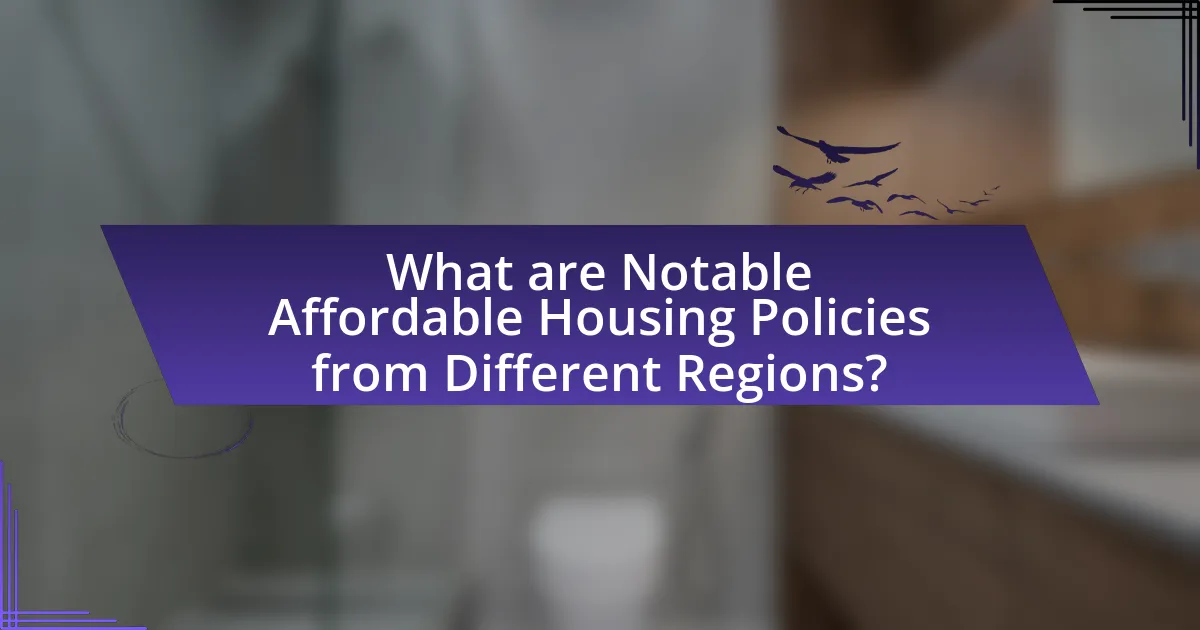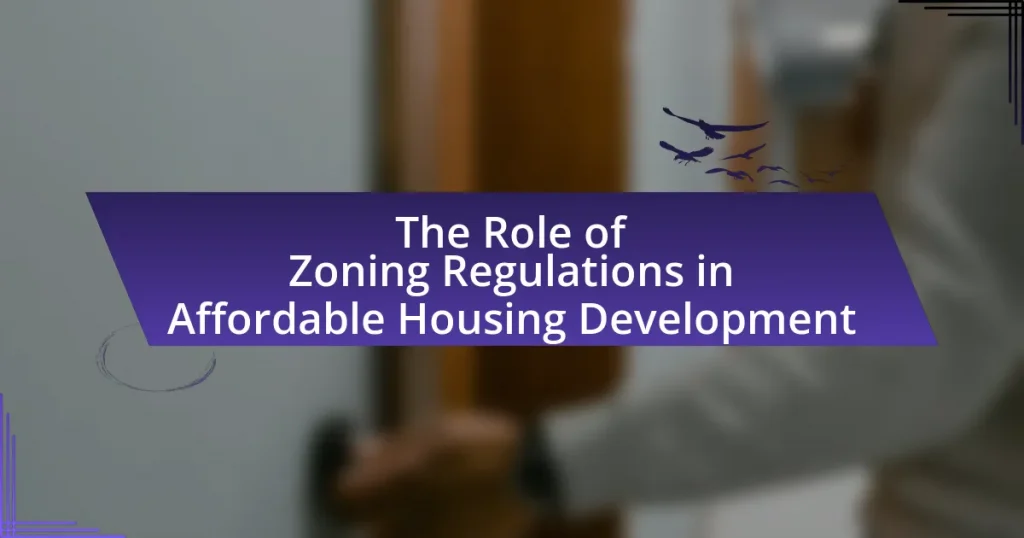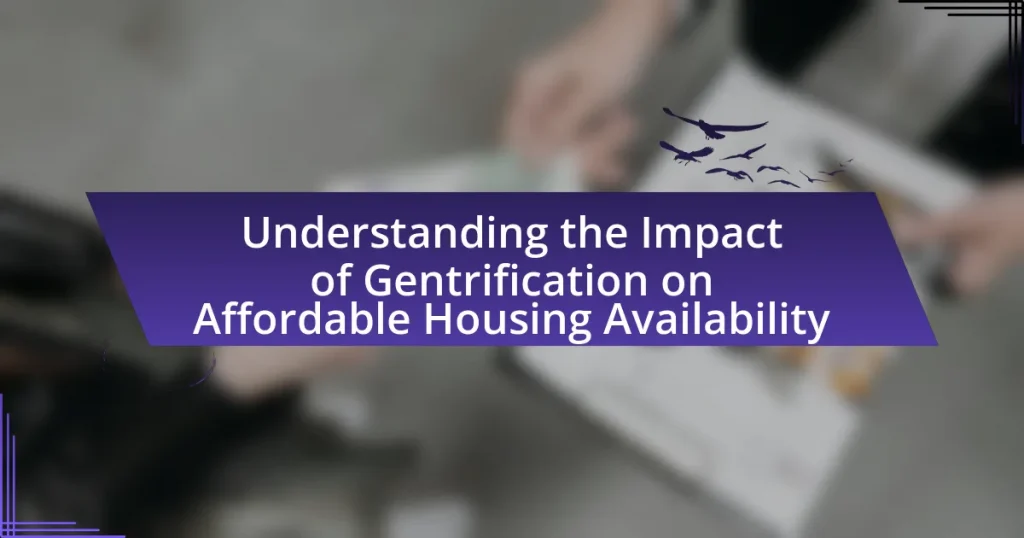The article examines affordable housing policies implemented globally, highlighting various strategies used by governments and organizations to ensure housing accessibility relative to income. It discusses how different countries define affordable housing, the criteria for classification, and the significant impact of income levels on these definitions. The article also addresses the critical issue of inadequate affordable housing, its social implications, and the economic stability it influences. Furthermore, it explores notable policies from regions such as North America, Europe, and Asia, while identifying common challenges and future trends in affordable housing initiatives.

What are Affordable Housing Policies Globally?
Affordable housing policies globally are strategies implemented by governments and organizations to ensure that individuals and families can access housing that is affordable relative to their income. These policies vary widely across countries and often include measures such as rent control, inclusionary zoning, housing vouchers, and public housing development. For instance, in the United States, the Low-Income Housing Tax Credit program incentivizes private developers to create affordable rental housing, while in Singapore, the Housing and Development Board provides subsidized public housing to a significant portion of the population. According to the United Nations, approximately 1.6 billion people worldwide lack adequate housing, highlighting the critical need for effective affordable housing policies.
How do different countries define affordable housing?
Different countries define affordable housing based on income levels and housing costs relative to those incomes. For instance, in the United States, affordable housing is typically defined as housing costs that do not exceed 30% of a household’s gross income, as established by the U.S. Department of Housing and Urban Development. In contrast, the United Kingdom uses a similar metric, where affordable housing is defined as housing that is available to those whose needs are not met by the market, often linked to local income levels. Meanwhile, in Canada, affordable housing is defined as housing that costs less than 30% of a household’s income, with specific programs targeting low-income families. These definitions reflect varying economic conditions and policy frameworks across countries, emphasizing the relationship between income and housing costs as a central theme in affordable housing definitions.
What criteria are used to classify housing as affordable?
Housing is classified as affordable when it costs no more than 30% of a household’s gross income. This criterion is widely recognized by various housing authorities and organizations, including the U.S. Department of Housing and Urban Development (HUD). The rationale behind this threshold is that spending beyond this percentage can lead to financial strain, limiting a household’s ability to afford other essential needs such as food, healthcare, and education. Additionally, affordability can also be assessed based on the local median income levels and housing market conditions, ensuring that the classification reflects the economic realities of different regions.
How do income levels influence the definition of affordable housing?
Income levels significantly influence the definition of affordable housing by determining what percentage of a household’s income can be allocated to housing costs. Generally, affordable housing is defined as housing that costs no more than 30% of a household’s gross income. For instance, a household earning $50,000 annually should ideally spend no more than $15,000 on housing, which translates to a monthly rent of approximately $1,250. This benchmark varies across different regions and income brackets, as higher income levels may allow for a higher percentage of income to be spent on housing, while lower income levels necessitate stricter definitions to ensure housing remains accessible. According to the U.S. Department of Housing and Urban Development, the definition of affordable housing is adjusted based on local median income levels, reflecting the economic conditions and housing market dynamics in various areas.
Why is affordable housing a critical issue worldwide?
Affordable housing is a critical issue worldwide because it directly impacts economic stability, social equity, and public health. The lack of affordable housing leads to increased homelessness, overcrowding, and financial strain on low-income families, which in turn exacerbates poverty levels. According to the United Nations, over 1.6 billion people globally lack adequate housing, highlighting the scale of the crisis. Furthermore, studies indicate that inadequate housing conditions contribute to health problems, with the World Health Organization linking poor housing to increased rates of respiratory diseases and mental health issues. Thus, the urgency of addressing affordable housing is underscored by its profound effects on individuals and communities across the globe.
What are the social implications of inadequate affordable housing?
Inadequate affordable housing leads to significant social implications, including increased homelessness, social inequality, and diminished community cohesion. The lack of affordable housing options forces low-income families into substandard living conditions or homelessness, which can exacerbate health issues and limit access to education and employment opportunities. According to the National Alliance to End Homelessness, in 2020, over 580,000 individuals experienced homelessness in the United States, highlighting the direct correlation between housing affordability and social stability. Furthermore, inadequate housing contributes to social inequality, as marginalized groups disproportionately face housing insecurity, perpetuating cycles of poverty and limiting upward mobility. This situation can erode community cohesion, as individuals and families are often displaced, leading to fragmented neighborhoods and weakened social networks.
How does affordable housing impact economic stability?
Affordable housing significantly enhances economic stability by reducing housing cost burdens on low- and moderate-income families. When families spend less on housing, they have more disposable income to invest in local economies, which stimulates growth and job creation. According to a study by the National Low Income Housing Coalition, every $1 invested in affordable housing generates approximately $1.50 in economic returns, demonstrating a clear link between affordable housing and economic vitality. Furthermore, stable housing contributes to better health outcomes and educational performance, which in turn fosters a more productive workforce, further reinforcing economic stability.
What are the common challenges faced in implementing affordable housing policies?
Common challenges faced in implementing affordable housing policies include funding limitations, regulatory barriers, and community opposition. Funding limitations arise from insufficient government budgets and reliance on private investment, which can hinder the development of affordable units. Regulatory barriers often involve complex zoning laws and building codes that delay projects and increase costs. Community opposition, or NIMBYism (Not In My Backyard), can lead to resistance against new developments, further complicating the implementation process. According to a report by the Urban Institute, these factors collectively contribute to the ongoing housing crisis in many regions, making it difficult to achieve the goals of affordable housing initiatives.
How do political factors affect affordable housing initiatives?
Political factors significantly influence affordable housing initiatives by shaping policy decisions, funding allocations, and regulatory frameworks. For instance, government priorities, influenced by political ideologies, determine the extent of investment in affordable housing programs. In the United States, the Housing and Urban Development (HUD) budget reflects political support for affordable housing; during the 2020 fiscal year, HUD allocated approximately $50 billion for various housing programs, demonstrating the impact of political will on funding. Additionally, local political dynamics, such as zoning laws and land use regulations, can either facilitate or hinder the development of affordable housing. For example, cities with progressive leadership often implement policies that promote density and mixed-use developments, while conservative administrations may prioritize single-family zoning, limiting affordable housing options. Thus, the political landscape directly affects the effectiveness and reach of affordable housing initiatives.
What role does funding play in the success of affordable housing policies?
Funding is crucial for the success of affordable housing policies as it directly influences the availability and quality of housing options. Adequate financial resources enable governments and organizations to develop, maintain, and subsidize affordable housing projects, ensuring they meet the needs of low-income populations. For instance, a study by the National Low Income Housing Coalition in 2021 highlighted that a lack of funding resulted in a shortfall of 7 million affordable rental homes for extremely low-income renters in the United States. This demonstrates that without sufficient funding, affordable housing initiatives struggle to achieve their objectives, leading to increased homelessness and housing instability.

What are Notable Affordable Housing Policies from Different Regions?
Notable affordable housing policies from different regions include Singapore’s Housing and Development Board (HDB) program, which provides subsidized public housing to over 80% of its residents, ensuring affordability and accessibility. In Germany, the Mietpreisbremse (rent control) law limits rent increases in certain areas, helping to maintain affordable housing options in urban centers. Additionally, the United States has implemented the Low-Income Housing Tax Credit (LIHTC) program, which incentivizes private developers to create affordable rental housing, resulting in over 3 million affordable units since its inception in 1986. These policies demonstrate diverse approaches to addressing affordable housing challenges globally.
How do European countries approach affordable housing?
European countries approach affordable housing through a combination of government intervention, social housing programs, and regulatory frameworks. For instance, countries like Germany and the Netherlands emphasize the development of social housing, where the government provides subsidies to ensure that housing remains affordable for low-income families. In Germany, approximately 30% of the housing stock is social housing, which is maintained through rent controls and tenant protections. Similarly, in France, the government has implemented policies such as the “Loi SRU,” which mandates that municipalities maintain a minimum percentage of social housing, ensuring access for lower-income residents. These strategies reflect a commitment to maintaining affordable housing as a fundamental right, supported by various legislative measures and financial incentives.
What specific policies have been successful in countries like Germany and Sweden?
Germany and Sweden have successfully implemented policies such as rent control and social housing initiatives to address affordable housing challenges. In Germany, the Mietpreisbremse (rent control law) limits rent increases in certain areas, helping to stabilize housing costs for tenants. Additionally, the country has invested in social housing projects, with approximately 1.5 million social housing units available, ensuring access for low-income families.
In Sweden, the use of a regulated rental market allows for lower rents in comparison to market rates, which benefits tenants. The Swedish government also supports the construction of new affordable housing through subsidies and incentives, leading to the creation of over 100,000 new homes annually in recent years. These policies have contributed to maintaining housing affordability and reducing homelessness in both countries.
How do cultural factors influence housing policies in Europe?
Cultural factors significantly influence housing policies in Europe by shaping societal values, preferences, and priorities regarding living conditions. For instance, in countries like Sweden and Denmark, a strong emphasis on social welfare and community well-being drives policies that promote affordable housing and inclusive urban development. This is evidenced by Sweden’s “Million Program,” which aimed to construct a million homes in a decade during the 1960s and 1970s, reflecting the cultural commitment to social equity and accessibility. Additionally, cultural attitudes towards homeownership versus rental markets vary across Europe; in Germany, a cultural preference for renting has led to robust tenant protections and a stable rental market, contrasting with countries like Spain, where homeownership is culturally favored, influencing policies that support property purchase incentives. These cultural dimensions directly impact legislative frameworks, funding allocations, and the overall approach to housing in various European nations.
What strategies are employed in North America for affordable housing?
North America employs various strategies for affordable housing, including inclusionary zoning, public-private partnerships, and federal funding programs. Inclusionary zoning mandates that a percentage of new developments be set aside for low-income residents, effectively increasing the stock of affordable units. Public-private partnerships leverage resources from both sectors to finance and develop affordable housing projects, enhancing efficiency and innovation. Federal funding programs, such as the Low-Income Housing Tax Credit, provide financial incentives to developers to create affordable housing, resulting in the construction of thousands of units annually. These strategies collectively address the growing demand for affordable housing in urban areas across North America.
What are the key features of the U.S. Housing Choice Voucher Program?
The U.S. Housing Choice Voucher Program provides rental assistance to low-income families, enabling them to afford housing in the private market. Key features include tenant-based vouchers, which allow recipients to choose their housing, and a subsidy that covers the difference between 30% of the family’s income and the local fair market rent. The program is administered by local public housing agencies, which determine eligibility based on income and family size. Additionally, the program promotes housing mobility and integration by allowing vouchers to be used in various neighborhoods, thereby supporting diverse communities.
How do Canadian policies differ from those in the U.S.?
Canadian policies on affordable housing prioritize social welfare and government intervention more than U.S. policies, which tend to emphasize market-driven solutions. In Canada, the federal government has implemented programs like the National Housing Strategy, which allocates billions for affordable housing development and aims to reduce homelessness by 50% by 2027. In contrast, U.S. policies often rely on tax incentives and private sector involvement, such as the Low-Income Housing Tax Credit, which provides tax breaks to developers but does not guarantee affordability. This fundamental difference reflects Canada’s commitment to a more centralized approach to housing as a human right, while the U.S. approach is more fragmented and market-oriented.
What innovative approaches are seen in Asia for affordable housing?
Innovative approaches for affordable housing in Asia include modular construction, community land trusts, and the use of technology for smart housing solutions. Modular construction, utilized in countries like Japan and China, allows for faster and more cost-effective building processes, reducing overall housing costs. Community land trusts, seen in places like India, enable communities to collectively own land and develop affordable housing, ensuring long-term affordability. Additionally, technology-driven solutions, such as smart home systems and digital platforms for housing management, are being implemented in countries like Singapore to enhance living conditions while keeping costs manageable. These approaches are supported by various government initiatives and private sector investments aimed at addressing the growing housing crisis in urban areas across Asia.
How does Singapore’s public housing model work?
Singapore’s public housing model operates primarily through the Housing and Development Board (HDB), which is responsible for planning and developing affordable housing for the majority of the population. Approximately 80% of Singaporeans live in HDB flats, which are sold at subsidized prices to eligible citizens, ensuring affordability and accessibility. The model emphasizes a mix of public and private financing, with the government providing significant subsidies and incentives to promote home ownership.
Additionally, the HDB incorporates a range of amenities and services within residential areas, fostering community living and social cohesion. The success of this model is evidenced by Singapore’s high home ownership rate, which stands at around 90%, and the efficient use of land through high-density developments. This approach has been recognized globally as a leading example of effective public housing policy.
What lessons can be learned from China’s rapid urbanization and housing policies?
China’s rapid urbanization and housing policies demonstrate the importance of government intervention in managing urban growth and ensuring affordable housing. The Chinese government implemented policies such as the construction of large-scale public housing projects and the establishment of land-use regulations to control urban sprawl. For instance, between 2000 and 2020, China built over 30 million affordable housing units, significantly reducing urban poverty and improving living conditions for millions. This approach highlights the effectiveness of coordinated policy efforts in addressing housing shortages and urbanization challenges, providing a model for other countries facing similar issues.

What are the Future Trends in Affordable Housing Policies?
Future trends in affordable housing policies include increased emphasis on sustainability, integration of technology, and enhanced public-private partnerships. Governments are prioritizing eco-friendly building practices to reduce environmental impact, as seen in initiatives like the Green Building Council’s standards, which promote energy-efficient designs. Additionally, technology is being leveraged to streamline housing development processes and improve accessibility, with tools like digital platforms for housing applications and data analytics for better resource allocation. Public-private partnerships are becoming more common, allowing for shared investment in affordable housing projects, which can lead to innovative financing solutions and broader community engagement. These trends reflect a shift towards more holistic and inclusive approaches to addressing housing affordability challenges globally.
How is technology shaping the future of affordable housing?
Technology is significantly shaping the future of affordable housing by enabling innovative construction methods, enhancing design efficiency, and improving access to housing data. For instance, 3D printing technology allows for the rapid construction of homes at a fraction of traditional costs, with projects like ICON’s 3D-printed homes in Austin, Texas, demonstrating the potential to reduce building time and expenses. Additionally, modular construction techniques streamline the building process, allowing for quicker assembly and reduced waste, as seen in initiatives like the Factory OS project in California, which aims to produce affordable housing units efficiently. Furthermore, data analytics and smart technology improve housing accessibility by identifying areas of need and optimizing resource allocation, as evidenced by platforms like Zillow and Redfin, which provide real-time housing market data. These technological advancements collectively contribute to making affordable housing more attainable and sustainable.
What role do smart cities play in enhancing affordable housing solutions?
Smart cities enhance affordable housing solutions by leveraging technology and data to optimize urban planning and resource allocation. These cities utilize smart infrastructure, such as sensors and data analytics, to identify housing needs, streamline construction processes, and improve access to essential services. For instance, cities like Barcelona have implemented smart housing initiatives that integrate real-time data to monitor housing availability and affordability, resulting in more efficient use of land and resources. Additionally, smart cities can facilitate public-private partnerships, enabling innovative financing models that support the development of affordable housing projects. This approach not only addresses housing shortages but also promotes sustainable urban growth, as evidenced by initiatives in cities like Singapore, where smart technologies have been pivotal in creating inclusive housing policies.
How can data analytics improve housing policy effectiveness?
Data analytics can improve housing policy effectiveness by providing evidence-based insights that inform decision-making and resource allocation. By analyzing demographic data, housing trends, and economic indicators, policymakers can identify areas of need, assess the impact of existing policies, and forecast future housing demands. For instance, a study by the Urban Institute found that data-driven approaches in cities like San Francisco led to more targeted interventions, resulting in a 15% increase in affordable housing units over five years. This demonstrates that leveraging data analytics not only enhances the precision of housing policies but also ensures that they are responsive to the evolving needs of communities.
What are the emerging best practices in affordable housing?
Emerging best practices in affordable housing include the integration of mixed-income developments, community land trusts, and innovative financing models. Mixed-income developments promote social diversity and economic integration, which have been shown to enhance community stability and reduce poverty concentration. Community land trusts, such as those implemented in Burlington, Vermont, allow communities to collectively own land, ensuring long-term affordability and preventing displacement. Innovative financing models, including public-private partnerships and social impact bonds, leverage private investment for public good, as evidenced by successful projects in cities like San Francisco. These practices collectively aim to create sustainable, equitable housing solutions that address the growing demand for affordable living options globally.
How can community involvement enhance affordable housing initiatives?
Community involvement can enhance affordable housing initiatives by fostering local engagement, ensuring that developments meet the specific needs of residents. When community members participate in the planning and decision-making processes, they can provide valuable insights into local housing demands, preferences, and cultural considerations. For instance, studies have shown that projects with strong community input are more likely to succeed and be sustainable, as they reflect the desires and requirements of those who will inhabit them. According to a report by the Urban Institute, community-driven housing initiatives often lead to higher satisfaction rates among residents and lower rates of turnover, demonstrating the effectiveness of incorporating local voices in affordable housing strategies.
What are the benefits of public-private partnerships in housing development?
Public-private partnerships (PPPs) in housing development provide several key benefits, including increased funding, improved efficiency, and enhanced innovation. These partnerships leverage the strengths of both sectors; public entities contribute regulatory support and land access, while private companies bring capital investment and expertise in project management. For instance, a study by the World Bank highlights that PPPs can reduce project costs by up to 20% through shared resources and risk management. Additionally, PPPs often lead to faster project completion times, as seen in various successful housing initiatives across Europe and North America, where collaboration has streamlined processes and reduced bureaucratic delays.
What practical steps can be taken to advocate for affordable housing policies?
To advocate for affordable housing policies, individuals and organizations can engage in grassroots mobilization, which includes organizing community meetings to raise awareness about housing issues. This approach has been effective in cities like San Francisco, where community groups successfully lobbied for the Affordable Housing Bond, resulting in over $600 million allocated for affordable housing projects. Additionally, advocating for policy changes through direct communication with local representatives can influence legislative priorities; for instance, the National Low Income Housing Coalition reports that consistent advocacy efforts have led to increased funding for housing assistance programs. Collaborating with existing coalitions and leveraging social media platforms to amplify messages can further enhance outreach and impact.
How can individuals contribute to local affordable housing efforts?
Individuals can contribute to local affordable housing efforts by volunteering with organizations that focus on housing development and advocacy. Engaging with local nonprofits, such as Habitat for Humanity, allows individuals to participate in building homes and supporting community initiatives. Additionally, individuals can advocate for policy changes by attending town hall meetings and contacting local representatives to express support for affordable housing legislation. Research indicates that community involvement in housing initiatives can lead to increased funding and resources for affordable housing projects, as seen in cities where grassroots movements have successfully influenced local policies.
What resources are available for communities seeking to improve housing policies?
Communities seeking to improve housing policies can access various resources, including government programs, non-profit organizations, and research institutions. Government programs such as the U.S. Department of Housing and Urban Development (HUD) provide funding and technical assistance for affordable housing initiatives. Non-profit organizations like the National Low Income Housing Coalition offer advocacy tools and policy recommendations to support community efforts. Additionally, research institutions such as the Urban Institute publish studies and data that inform best practices in housing policy, helping communities to develop effective strategies. These resources collectively empower communities to enhance their housing policies through informed decision-making and collaboration.



